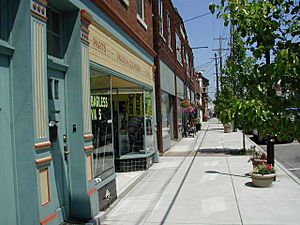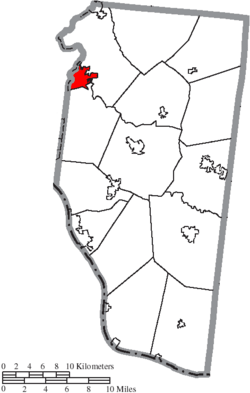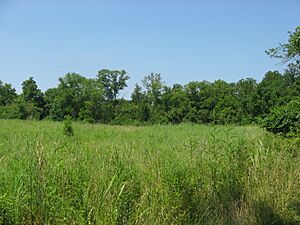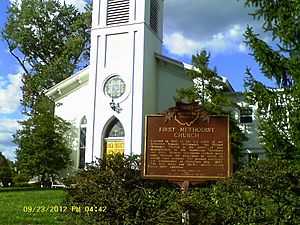Milford, Ohio facts for kids
Quick facts for kids
Milford, Ohio
|
|||
|---|---|---|---|

Main Street in Milford
|
|||
|
|||
| Motto(s):
"On the Little Miami"
|
|||

Location of Milford in Clermont County
|
|||
| Country | United States | ||
| State | Ohio | ||
| Counties | Clermont, Hamilton | ||
| Area | |||
| • Total | 3.84 sq mi (9.94 km2) | ||
| • Land | 3.71 sq mi (9.62 km2) | ||
| • Water | 0.12 sq mi (0.32 km2) | ||
| Elevation | 568 ft (173 m) | ||
| Population
(2020)
|
|||
| • Total | 6,582 | ||
| • Estimate
(2022)
|
6,470 | ||
| • Density | 1,773.17/sq mi (694.5/km2) | ||
| Time zone | UTC-5 (Eastern (EST)) | ||
| • Summer (DST) | UTC-4 (EDT) | ||
| ZIP code |
45150
|
||
| Area code(s) | 513 | ||
| FIPS code | 39-50176 | ||
| GNIS feature ID | 1085671 | ||
Milford is a city in Ohio, located in two counties: Clermont and Hamilton. It's in the southwestern part of Ohio, near the Little Miami River. Milford is also part of the larger Cincinnati metropolitan area. In 2020, about 6,582 people lived there.
Contents
History of Milford

The area where Milford is located was first surveyed in 1788. This survey was done by John Nancarrow, a soldier who fought in the American Revolutionary War. He hoped to create a big city there.
Milford was one of the first settlements in Clermont County. It started in 1796 where the Little Miami River and its East Fork meet. This makes Milford one of the oldest settlements in the county, along with Williamsburg.
The first settler was Reverend Francis McCormick, who was also a Revolutionary War soldier. He arrived in 1796 and built a log cabin. In 1797, he started the first Methodist church group in the Northwest Territory.
John Nancarrow sold his land to Philip Gatch in 1802. Later, parts of this land were sold to Ambrose Ranson and then to John Hageman. Hageman became an important early settler. He created a village with 46 lots, calling the area Hageman's Mills.

By 1811, the name Milford became popular. It's thought that a newspaper changed the name in 1806. This was because Milford had the first safe place to cross (a ford) the Little Miami River north of the Ohio River.
In 1806, Milford was just three blocks wide. Over the years, the town grew and added more areas. Milford officially became a village in 1836. Later, in 1982, it became a city because its population grew to over 5,000 people.
Because of Reverend McCormick and his church, Milford is known as an important place for the Methodist religion in the American West. The shallow river crossing that gave Milford its name can still be seen today.
A field near Gatch Avenue is known for having many artifacts. People believe it was once a Native American village during the Woodland period. This area is now called the Gatch Site and is managed by the Valley View conservancy.
Milford's Population
| Historical population | |||
|---|---|---|---|
| Census | Pop. | %± | |
| 1870 | 621 | — | |
| 1880 | 732 | 17.9% | |
| 1890 | 998 | 36.3% | |
| 1900 | 1,150 | 15.2% | |
| 1910 | 1,322 | 15.0% | |
| 1920 | 1,526 | 15.4% | |
| 1930 | 1,916 | 25.6% | |
| 1940 | 2,140 | 11.7% | |
| 1950 | 2,450 | 14.5% | |
| 1960 | 4,130 | 68.6% | |
| 1970 | 4,828 | 16.9% | |
| 1980 | 5,232 | 8.4% | |
| 1990 | 5,690 | 8.8% | |
| 2000 | 6,284 | 10.4% | |
| 2010 | 6,709 | 6.8% | |
| 2020 | 6,582 | −1.9% | |
| 2022 (est.) | 6,470 | −3.6% | |
| Sources: | |||
2020 Census Information
In 2020, Milford had 6,582 people living in the city. Most residents, about 91%, were White. About 1.6% were Black or African American, and 1.1% were Asian. About 2% of the population identified as Hispanic or Latino.
The city has about 3,191 households. About 24% of these households had children under 18 living with them. The average age in Milford was 46.4 years old. About 19.1% of the people were under 18, and 26.7% were 65 or older.
2010 Census Information
In 2010, there were 6,709 people living in Milford. The racial makeup was similar to 2020, with 94.6% White residents. About 21.4% of the people were under 18 years old. The average age was 43.2 years.
Milford's Economy
Milford is home to several important businesses and organizations. These include the main office for Penn Station sandwiches and Siemens Digital Industries Software. Other companies like Total Quality Logistics and Overhoff Technology also have operations here. The North American headquarters of Tata is in Milford, as well as the United Church of God.
Parks and Recreation

Milford has many green spaces and outdoor activities. The city has 10 parks, including the new Five Points Landing Park. This park has a dog park, a splash pad, and hosts the Milford Farmers Market on Saturdays.
New Finley Ray Park is where the Greater Milford Athletic Association plays sports. The Little Miami Bike Trail goes through Milford. This trail runs all the way from Newtown to Springfield, Ohio. Several other major hiking and cycling trails also meet in Milford.
Because Milford is in a river valley, it's a popular spot for kayaking and canoeing. Terrell Park, a park along the river, is named after Jim Terrell, a famous American sprint canoer. The Cincinnati Nature Center's main site, Rowe Woods, is also in the Greater Milford area.
City Fairs
Milford hosts fun events throughout the year:
- Milford Frontier Days: A main festival held in May and June.
- Art Affaire: A crafts festival that takes place in September.
Education in Milford
The Milford Exempted Village School District serves about 6,600 students. Milford High School is a highly-ranked school in Ohio. It offers 24 Advanced Placement (AP) courses, which are college-level classes.
Besides the high school, there is a middle school, a preschool, and six elementary schools. These elementary schools are McCormick, Meadowview, Mulberry, Pattison, Seipelt, and Smith. The Promont building houses the Greater Milford Area Historical Society, where you can find old yearbooks from Milford classes. Milford also shares a branch of the Clermont County Public Library.
Notable People from Milford
Milford has been home to several well-known individuals:
- Barry Bonnell: A former Major League baseball player.
- Markiplier: A popular YouTuber and vlogger.
- John M. Pattison: The 43rd Governor of Ohio.
See also
 In Spanish: Milford (Ohio) para niños
In Spanish: Milford (Ohio) para niños






